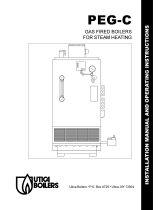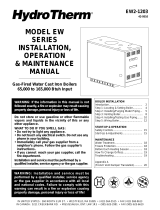
15
EQUIPMENT AND OPTIONAL ACCESSORIES - WHAT THEY DO
RELIEF VALVE
You must have a relief valve on your boiler. Water
expands as it is heated. If there is no place for the water
to expand into, water pressure will build up inside the
boiler and system. Should this happen, the relief valve
will automatically open at a predetermined pressure.
This will relieve the strain on the boiler and system. Run
a pipe from the relief valve outlet (pipe must be same
size as outlet and the open end must not be threaded)
to an open drain, tub or sink, or other suitable drainage
point not subject to freezing. Failure to do so may cause
water damage or injury should relief valve release.
EXPANSION TANK
In a properly assembled system, the expanding water
fl ows into a expansion tank. This tank should be of the
correct size. The tank is fi lled with air. As the water
expands it compresses the air in the tank to form an air
pressure cushion. This “spring-like” cushion serves to
maintain correct operating water pressure regardless of
water temperature. This assures a “full measure” of a
water, even in the highest radiation unit of the system.
It also prevents blowing off of the relief valve. The air
in the tank in the beginning (with system fi lled with
cold water) is suffi cient for proper operation. The tank
also serves as a trap for excess air in the system. The
air would cause gurgling in the pipes and ineffi cient
circulation in the radiators if left in the system .
It is possible for a tank to become “waterlogged” (fi lled
with water). It can also become overfi lled with air. This
can happen after fi lling the system with new water.
Fittings provided on the tank and in the line to the tank
are for bleeding off excess water or air.
When installing this tank, it is important: 1) That
the tank be higher than the boiler top. 2) That the
pipe to the tank continuously rises up to the tank
(so that air can “bubble” up to it).
DIAPHRAGM TYPE EXPANSION TANK
The diaphragm type expansion tank (EX-TROL) takes
the place of the conventional expansion tank. Carefully
read the instructions packed with your EX-TROL tank
assembly.
The EX-TROL tank comes to you with a 10-12 pounds per
square inch air charge. This is the same as the pressure
produced in the system by the automatic fi ll valve. When
the system is fi rst fi lled, the EX-TROL tank will contain
little or no water.
As the water is heated its pressure increases. It expands
into the EX-TROL tank, compressing the air in the
tank. This compressed air cushion permits the water
in the system to expand as the temperature changes.
The diaphragm type tank can be mounted on the air
purger fi tting or at any convenient place in the supply
or return line.
AIR ELIMINATING FITTING (AIR PURGER)
An air purger is used to remove excess air from the
system. It is installed in the supply line. It will eliminate
air from the water before it reaches the radiators and
bleed off this air.
MAIN AIR VENT FOR DOWN FLOW SYSTEMS OR
DIAPHRAGM TYPE EXPANSION TANK
Before a system is fi lled with water, there is air in the
pipes and radiation units. Some of it will be trapped as
the system is fi lled . It is possible to eliminate most of
this air through the air vent on the radiation units. A
main air vent will speed and simplify this. It should be
installed on the highest point in the supply main when
all radiation is below top of boiler.
AUTOMATIC FILL VALVE
For safe, effi cient operation, a hot water system must
be completely fi lled with water. Adding new water,
when needed can be done manually (by use of a hand
valve in the water supply line). This requires regular
attention to the system’s needs. An automatic fi ll valve
accomplishes this without attention. It is installed in the
supply line on hot water boilers only. The valve operates
through water pressure differentials. It does not require
an electrical connection.
DRAIN VALVE
This manual valve Provides a means of draining all water
from the boiler and system. It is often installed in the
3/4” tapping at the bottom of the end boiler section. Or
it can be installed in a tee where the return line enters
the boiler.
WATER TEMPERATURE CONTROL
The water temperature limit control in the relay is
adjustable
and may be set as necessary. It may be set as low as
140°F, or as high as 240°F. This depends on the type and
amount of radiation involved and weather conditions.
CIRCULATING PUMP
Every forced hot-water system requires a circulating
pump. A separate pump or zone valve is required for
each zone, if you have a two or more zone system. This
pump must have the capacity to provide the circulation
required by your system. The pump is connected into
the main just ahead of the boiler. It is also wired to the
electrical system.
VENT DAMPER
This product is an automatic, motorized stack damper
that has been developed to increase the effi ciency of
heating system by reducing standby losses from the
heating apparatus and the conditioned air space. The
damper closes the chimney vent when the burner is off
and fully opens it when combustion is required.






















